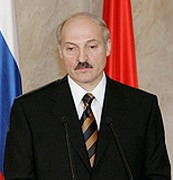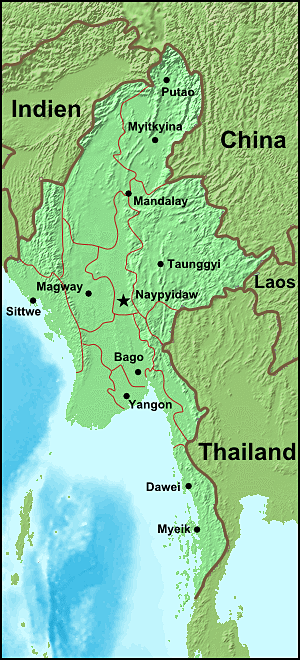
The International Monetary Fund (IMF) is a major financial agency of the United Nations, and an international financial institution funded by 190 member countries, with headquarters in Washington, D.C. It is regarded as the global lender of last resort to national governments, and a leading supporter of exchange-rate stability. Its stated mission is "working to foster global monetary cooperation, secure financial stability, facilitate international trade, promote high employment and sustainable economic growth, and reduce poverty around the world." Established on December 27, 1945 at the Bretton Woods Conference, primarily according to the ideas of Harry Dexter White and John Maynard Keynes, it started with 29 member countries and the goal of reconstructing the international monetary system after World War II. It now plays a central role in the management of balance of payments difficulties and international financial crises. Through a quota system, countries contribute funds to a pool from which countries can borrow if they experience balance of payments problems. As of 2016, the fund had SDR 477 billion.

The economy of Laos is a lower-middle income developing economy. Being one of the socialist states, the Lao economic model resembles the Chinese socialist market and/or Vietnamese socialist-oriented market economies by combining high degrees of state ownership with openness to foreign direct investment and private ownership in a predominantly market-based framework.
Special drawing rights are supplementary foreign exchange reserve assets defined and maintained by the International Monetary Fund (IMF). SDRs are units of account for the IMF, and not a currency per se. They represent a claim to currency held by IMF member countries for which they may be exchanged. SDRs were created in 1969 to supplement a shortfall of preferred foreign exchange reserve assets, namely gold and U.S. dollars. The ISO 4217 currency code for special drawing rights is XDR and the numeric code is 960.

The economy of Thailand is dependent on exports, which accounted in 2021 for about 58 per cent of the country's gross domestic product (GDP). Thailand itself is a newly industrialized country, with a GDP of 17.367 trillion baht (US$495 billion) in 2022, the 9th largest economy of Asia. As of 2018, Thailand has an average inflation of 1.06% and an account surplus of 7.5% of the country's GDP. Its currency, the Thai Baht, ranked as the tenth most frequently used world payment currency in 2017.

The economy of Vietnam is a developing mixed socialist-oriented market economy incorporating industrial policies and strategic five-year plans, which is the 35th-largest in the world as measured by nominal gross domestic product (GDP) and 26th-largest in the world as measured by purchasing power parity (PPP) in 2022. It is a lower-middle income country with a low cost of living. Vietnam is a member of the Asia-Pacific Economic Cooperation, the Association of Southeast Asian Nations and the World Trade Organization.

The Bretton Woods system of monetary management established the rules for commercial relations among the United States, Canada, Western European countries, and Australia among 44 other countries after the 1944 Bretton Woods Agreement. The Bretton Woods system was the first example of a fully negotiated monetary order intended to govern monetary relations among independent states. The Bretton Woods system required countries to guarantee convertibility of their currencies into U.S. dollars to within 1% of fixed parity rates, with the dollar convertible to gold bullion for foreign governments and central banks at US$35 per troy ounce of fine gold. It also envisioned greater cooperation among countries in order to prevent future competitive devaluations, and thus established the International Monetary Fund (IMF) to monitor exchange rates and lend reserve currencies to nations with balance of payments deficits.
Structural adjustment programs (SAPs) consist of loans provided by the International Monetary Fund (IMF) and the World Bank (WB) to countries that experience economic crises. Their stated purpose is to adjust the country's economic structure, improve international competitiveness, and restore its balance of payments.
Thailand joined the IMF on May 3, 1949 and has been the recipient of numerous IMF programs, most notably in its role as the source of contagion in the 1997 Asian financial crisis. Thailand currently has a quota of 3,211.9 million SDR's, which gives it the second most voting power in its constituency after Turkey. The IMF opened a technical assistance office in Thailand in 2012 to provide technical assistance and training to the Lao PDR and the Republic of the Union of Myanmar.
In 1945, China cofounded the International Monetary Fund (IMF) with 34 other nations. China was initially represented by the Republic of China. In April 1980, representation transferred to the People's Republic of China. The Chinese-IMF relationship mainly operates around affairs associated with IMF governance and the IMF Special Drawing Rights (SDR).
El Salvador has been a member of the International Monetary Fund (IMF) since 1946. Their quota currently consists of 287.20 million SDR. The country has received loans from the IMF in the past, but most recently has received only standby loans and currently has no outstanding payments. As of June 2017, the standby arrangements total 1,442,300 SDR while the government has only drawn upon 132,250 SDR.
The International Monetary Fund (IMF) has operated in Malawi since 1965.
Iceland joined the International Monetary Fund on Dec 27th 1945, becoming one of the IMF's founding members. As a part of the IMF, Iceland has rights in accordance with its contributions, borrowing rights which help facilitate the stability of global financial markets. Iceland's quota is 321.8 million SDR, and its Special Drawing Rights are 112 million. This is a relatively small quota and its vote share comprises only 0.09% of all IMF vote shares, or 4,683 votes to be exact.

Portugal joined International Monetary Fund (IMF) on March 29, 1961. They joined by submitting 100 percent of their quota, which is 2,060.10 SDR. Currently, Portugal is using 187.5 percent of their quota, which is 3,862.69 SDR. Portugal has not had an IMF disbursement since 2014. Portugal has just .44 percent of voting power in the IMF.
South Korea and the International Monetary Fund (IMF) partner together to assist the country in managing its financial system. South Korea's economy is considered fundamentally sound because of the balance of their banking sector and their aim toward a zero structural balance without compromising their ability to sustain debt. The IMF Board in 2019 assessed that the policy framework and financial system in place are sturdy and firmly set.

The Republic of Belarus became a member of the International Monetary Fund on July 10, 1992 and has since taken out a significant amount of loans to stabilize their economy, balance of payments and hyperinflation. Belarus IMF quota is 681.5 millions of special drawing rights (SDR), 0.14% of IMF total. They have 8,280 number of votes, which independently gives them a .16% voting share. Pavel Kallaur currently holds the board of Governor seat. When it comes to voting power Belarus is grouped in the constituency system consisting of Austria, Czech Republic, Hungary, Kosovo, Slovak Republic, Slovenia, and Turkey- together they have 162,344 total votes with 3.23% percent of fund total. Raci Kaya is currently the Board of Governor for the constituency system.
Cambodia officially joined the IMF on December 31, 1969. After years of internal and external strife, the Cambodian government is currently focusing its attention to rebuilding and renovating the national economy through grants and loans from multilateral sources like the International Monetary Fund. Cambodia gained independence in 1953, which was the starting point of industrialization. Cambodia faced a downhill between 1975 till 1979, which damaged all the infrastructure and economy, economical and a tragic event — genocide which killed millions of innocent citizens and especially the loss of human resources, which caused the Cambodian economy to drop to the lowest point. The Cambodian economy started lively in 1993, hugely relying on the foreign market to export agricultural produce, especially rice. In March 1994, the International Committee for the Reconstruction of Cambodia (ICORC) developed a comprehensive plan in effort to support Washington Consensus policy prescriptions. These reforms aimed to shift the economy from a socialist state-controlled economy towards a capitalistic market-controlled one. Since then they've had a total of two arrangements addressing fiscal management. Directors approved a loan for SDR 28.0 million in support of Cambodia's 1995-96 macroeconomic and structural reformations. In 1997 domestic political uncertainty following an alleged coup d’état halted IMF disbursements but resumed again in 1998 after the formation of a new government. Since the 1990s there have been no active IMF loans, but Cambodian and IMF relations continue through Technical Assistant strategies and yearly Article IV reports.

Myanmar, officially joined the International Monetary Fund (IMF) as of January 3, 1952; shortly before the end of term for the Union of Myanmar's first President, Sao Shwe Thaik, and the induction of Ba U. Since the induction of Myanmar as a member of the institution, they have made six arrangements with the IMF with its most recent arrangement made in 1981. As of 2019, they are currently led by Kyaw Kyaw Maung and Alternate U Soe Thein; their Special Drawing Rights (SDR) is at 0.79 million and quota consists of $516.8 million SDR which is 0.11% of the total IMF funds available. As of 2019, the country is under one of the twenty-four Executive Boards that facilitates the day-to-day operations of the IMF, led by Alisara Mahasandana and Alternate Keng Heng Tan; their co-board members consist of Brunei Darussalam, Cambodia, Republic of Fiji, Indonesia, Laos, Malaysia, Nepal, Philippines, Singapore, Thailand, Tonga, and Vietnam. The Executive Board accumulates around 218,545 total votes which account for 4.34% of the Fund's total, Myanmar allocates 6,633 of the votes.
Iran and the International Monetary Fund have been in partnership since 1945. Iran has gone to the IMF on only two occasions, both before the 1979 revolution of Iran.
International Monetary Fund (IMF) has a history of granting conditional loans to Morocco. This article describes the relationship between Morocco and the IMF since it joined in 1958. The IMF has typically worked to promote liberalization of the Moroccan economy and to maintain the stability and liquidity of finances in both the public and private sectors.
Serbia has been a member of the International Monetary Fund (IMF) since December 14, 2022 with a quota of Special Drawing Rights (SDR) 654.8 million and 8,0007 votes. Serbia is currently represented on the Executive Board by Piotr Trabinski in a constituency with Azerbaijan, Kazakhstan, the Kyrgyz Republic, Poland, Serbia, Switzerland, Tajikistan, Turkmenistan, and Uzbekistan that holds 2.88% of the total vote share.








